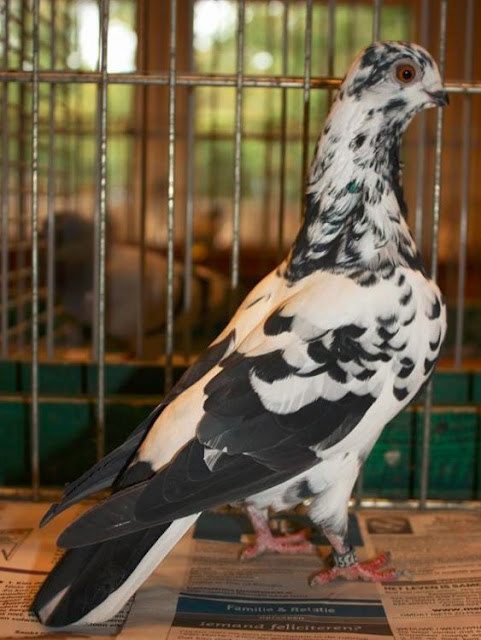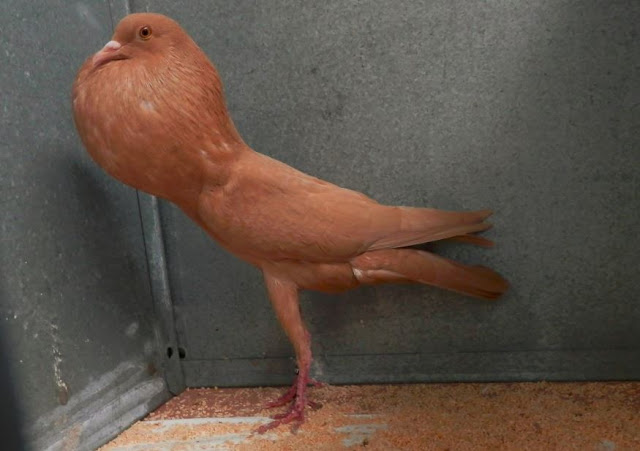A short highly informative video on how to take care of your birds during Off Season
Pigeon Genetics - Lecture on Lemon Project
Drew Lobenstein is a renowned pigeon geneticist and an NPA Master Breeder. In this lecture Drew shows his Lemon project out of the over 30 genetic projects being carried on in his loft (wow!!!). He has successfully created the lemon color on various famous show pigeon breeds .
Drew Lobenstein Lecture On Lemon Project - Part 1
Drew Lobenstein Lecture On Lemon Project - Part 2
Valencian Frill ( Figurita Mövchen )
The breed is distinguished as the French and Spanish type . At the French type we see in general more rounded heads and as in the French standard the type is described as slightly elevated , the French Valencian Frills are more horizontal in position.Besides that they are also larger.The Spanish Valencian Frills have an angular, trapezium from head shape, with a beak following the descending front headline. These birds are mostly good positioned in a good upright position, were the vertical line from the eye ends just before the legs. The tail must be reach the ground. These are often the smallest types.
 |
 |
French Bagdad ( Französische Bagdette )
Origin
This breed is thought to be of Arabian origin. It has been kept in France since ages.
Overall Impression
A large bird with elevated proud bearing, a balanced, high stance, rugged forms and powerful looks. Long neck and long beak. Wings and tail are short. The feathering is tight, several patches are scarcely feathered or even naked, showing the red pigmented skin. This is very typical for the breed. The weight is 700 to 900 grams, respectively for the hens and the cocks.
Features of the Breed
Head: Powerful and long, arched, while the back of the head is strongly rounded and passing into the neck. Seen from aside, the beak is proceeding in shape to the head line, with only a minor submerging right behind the beak. Seen from above, the head is wedge-shaped.
Beak: Long, from the beginning of the beak (the gape) to the tip, the length should measure 35 to 38 mm. Thick at the base, the lower beak as substantial as the upper beak. The tip of the upper mandible is slightly arched and stumpy. Beak colour preferably as light as possible, pinkish around the wattle. White to slightly yellowish in the Red, Yellow and Dun. Horn colour in the other colour varieties, a somewhat darker beak point is tolerated.
Beak wattle: Level, but somewhat rough on the outer surface, level. Colour is rose-white.
Eyes:Very large, prominent and expressive. Pearl colour, some tolerance for granulation (sand colour). The Whites and Pieds have dark or bull eyes, but pearl eyes are allowed. The eye ceres are wide, fine structured with a blood red colour.
Neck: Very long, in proportion to the length of the legs, almost the same thickness from the shoulders to the sharply defined throat. Held vertical and in the middle, slightly curved forward ( the Baghdad Knot/ a slight kink in the fourth neck vertebrae (a breed feature) Shoulders powerful and square set.
Breast: Broad and lightly rounded with a lifted and prominent breast bone.
Back: Broad, short and wedge-shaped, slightly hollow and narrowing towards the rear.
Wings: Short, wing tips carried on the tail, reaching up to 4 to 5 cm of the end of the tail. Wing shields are flat with the wing butts slightly lifted and held slightly away from the Breast.
Tail: Well closed, not too long and slightly sloping.
Legs: Long and powerful, heavy in bone and very muscular, bent in knee joints. When we hold the legs against the tail, the legs are 3 cm longer that the tail. Legs are set well apart, about 5 cm. The thighs are broad and very muscular, protruding. The shanks are very long, featherless, the toes long and wide spread. The nails are large, white or black depending on the plumage colour.
Plumage: Very short, tight and sparsely feathered. At several places the naked skin is showing, i.e. the face, shoulder, around the eye ceres, thumbs and along the breast bone. An intensely red skin colour showing at these spots will increase the breed value of the bird.
Colours: white, black, dun, red, yellow, brown, khaki and Andalusian blue. Chequered, barre dor barless: dominant red, dominant yellow, blue, silver, brown and khaki.
Grizzle: red, yellow, blue, silver, brown and khaki. Blue indigo, barred and chequered.
Pied: black, dun, red, yellow, brown, khaki, and Andalusian blue
Faults: Too small, too round in body, bad neck carriage, short neck, tail and/or wings too long, short legs, drooping tail, very noticeable forehead, submerging between beak and forehead, thin, pointed or curved beak, rough beak cere, too densely feathered, plumage too long and soft, pale eye ceres, noticeable dewlap, no pearl eyes (except White and Pied, which have dark eyes) or too coarsely granulated eyes (sand colour).
The Maltese ( Malteser )
Brought to Austria and Southern Germany in 1850 from upper Italy.The Maltese pigeon is a radical departure from the common type of pigeon in that it stands high on straight legs, has a very long slender neck and a short tucked up body
The bird should be very tall,with a short hard compact body and not so heavy as to mar the elegance or its figure nor its grace.it should carry its head high and when driving throw its head backward almost to its tail. An ideal specimen should stand fifteen or more inches in height.Eyes are somewhat deep set, whites to have bull eyes,the other colors to have orange eyes.Whites to have red eye ceres;blacks and blues damson cere;reds,yellow,duns, and silvers flesh colored cere.Beak is stout and of medium length,with the upper beak slightly bent.In blacks and blues the beak should be black. In all other colors the beak should be flesh colored,the wattle should be smooth and powder white.The neck is very long and carried erect, as nearly the same thickness as possible until approaching the shoulder.Breast should be relatively wide in proportion to overall appearance and carried high showing good depth of keel.Belly to be short and round , rump to be well developed and feathered,the body should appear cubed not long and cylindrical. Back is short and moderately broad, horizontal and with slight elevation at rump.Flights are very short,lying close,carried well up, wing butts prominent and projecting slightly outward at breast. Flights to meet at center of tail with slight crossing permitted.Thighs to be powerful and long and should show as much as possible, very closely feathered. legs below the hock to be straight, very long, free of feathers, joints not be bent ,toes to be long and set well apart.Plumage is short and closely fitting.
Brunner Pouter ( Brünner Kröpfer )
Standard description
Head: Fine, rather long and slightly arched.
Eye: Bull in Whites and Gansel marked. Orange to yellow in other colours. The eye ceres almost imperceptible. Light to dark but never red.
Beak: Medium in length, fine and slender. Flash colour in Whites and Yellows. Horn colour in Black and intense colours. Wattle, white and smooth.
Neck: As long as possible.
Globe: High set, cut out well from the body, showing back crop, as round as a ball, the widest part in the centre.
Breast: Breast Bone straight and set well forward. Body long and slim.
Back: Long and narrow between the shoulders, sloping and straight with the tail.
Wings: Long and well set, carried well up the butts, held high on the rump. Primaries crossed. When in action, the wing shields are carried 1 to 2 cm from the drawback.
Tail: Narrow and firmly closed, a little longer than the wings and carried clear of the ground. In a line with the back. Wry or ‘fish’ tail a serious drawback.
Legs : Long and slender, not close at the juncture of the body. When viewed from the front perfectly straight. The side view showing the eye above the centre toe. Thighs moderately prominent running almost imperceptible into body hocks, just slightly bent, not frog jointed. Toes medium to long, slender and un-feathered from the hock down, toenails as beak colour. The length of leg being slightly less than half of the total height of the Brunner.
Feathers: Clean, silky when in the hand. Lustrous in colour. Thighs well covered and smooth.
Left to Right :
1: Ideal Brunner pouter,
2:Too plump in body
3:Narrow legs
4:Cow hocked 'X' -legged
Brunner Pouter, Brünner Kröpfer , Boulant Brunner,Gozzuto di Brno, Brünner Kropper
Limerick Tumbler ( Limerick-Tümmler )
The Breed is from the Limerick District of Southern Ireland , Its a medium size , short, coddy , round headed and full muffs,
Head:Proportionate to the size of the body. In profile it is rising off and over the wattle with a roundness which continues as perfectly as possible to the back of the head with the top skull directly over the eyes. From the front it is broad and full
Eyes:Pearl or white are preferred. Almonds can carry a darker eye. Eye cere to be smooth and thin, colour appropriate to the plumage.
Beak:Less than medium in length, in proportion to the head. Not too thick or blunt (boxed).
Neck:Broad at the base, thick neck tapering slightly to the throat. (bell shaped).
Breast:Broad and well rounded.
Back:Rather short, broad across the shoulders, narrowing towards the rear, slightly sloping.
Wings:Medium in length, carried on the tail.
Tail:Short and well closed. Following the line of the back but carried clear off the ground.
Legs: medium length, with medium to heavy, full, well proportioned semi-circular sideways muffs. They should not be too long, nor have any gaps. The stance should look low on the legs.
Feathers: Smooth, close fitting but not too long.
Colour and markings: All colours to be clear and as intense as possible. Bars and Checkering to be well defined.
Colours: Black, Dun, Red, Yellow, Blue, Silver, Brown,Khaki, Bronze, Sulfur,Tortoiseshell, Almond, Deroy , Qualmond, Andalusian. All colour groups to include Bar and Checker.
Faults: Too long in Body, Legs and Beak. Narrow chest. Wrong shaped head. Insufficient or badly shaped muffs. Too upright or horizontal in stance.
Limerick Tumbler, Limerick-Tümmler,Culbutant de Limerick,Capitombolante di Limerick
The Limerick Tumbler Club
Limerick Tumbler, Limerick-Tümmler,Culbutant de Limerick,Capitombolante di Limerick
Subscribe to:
Posts (Atom)




































































